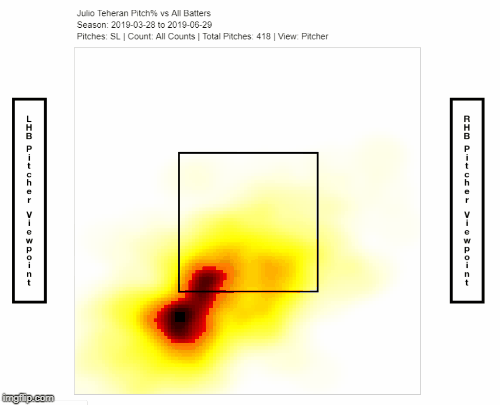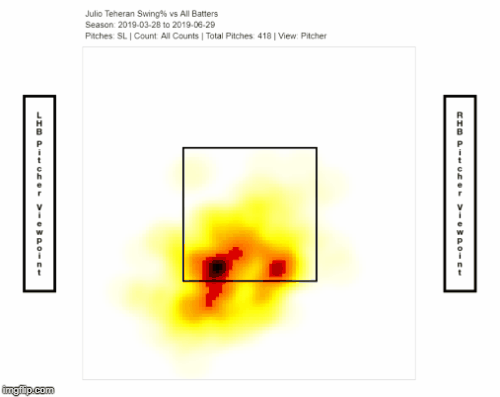Julio Teheran is Pitching to Contact But Gettting Strikeouts
When Julio Teheran takes the mound against the Mets at SunTrust Park on Thursday night, he will be looking to extend a hot streak that extends back to the beginning of July. Over his last seven starts encompassing 42.1 innings, Teheran has registered a 1.91 ERA and a 1.06 WHIP. Since July 1, Teheran ranks 30th in Roto value among starting pitchers (per CBSSports.com rankings), and he would place in the top 20 if not for inconsistent run support and a Luke Jackson blown save that cost him a win against the Nationals on July 19. Despite excellent ratios, Teheran is just 2-1 over this stretch.
When a pitcher gets more strikeouts and reduces walks and home runs, an increase in fantasy value is to be expected, and Teheran has recently been accomplishing all three things. The decrease in his walk rate is the most dramatic of the improvements and also the most needed. Over the preceding season-and-a-half, Teheran’s walk rate was a lofty 11.7 percent, but over his last seven outings, that rate is a slightly-below-league-average 8.1 percent. He did not have a home run problem over the first three months of this season, as evidenced by his 1.05 HR/9, but since then, he has been even better at keeping the ball in the park with an 0.85 HR/9.
There is a clear explanation for Teheran’s improved walk and home run rates — he has swapped out some of his slider usage in order to throw more sinkers. Through his first 13 starts, he used sinkers only 14.5 percent of the time, while throwing sliders at a 26.1 percent rate. In his seven most recent starts, he has basically reversed his usage patterns of the two pitches, throwing his sinker at a 27.5 percent rate and his slider at a 16.8 percent rate. (There are five starts in between these two time periods that are unaccounted for, but I will get to that shortly.) That change was a sure-fire way for Teheran to lower his walk rate, as he has thrown his sinker in the strike zone at a 47.8 percent rate, as compared to his 26.4 percent Zone% for his slider. His sinker has not only been a better ground ball pitch (56.2 percent GB%) than his slider (44.0 percent GB%), but it’s been one of the best sinkers in the majors in terms of limiting hard contact (90.6 mph EV FB/LD, classified by Baseball Savant as a two-seam fastball). Teheran has allowed 91 sinkers to be put in play this season, and not a single one has been hit for a home run.
In light of Teheran’s increased sinker usage, it is hard to make sense of his recent surge in strikeouts. Sinkers are typically the worst pitch for getting swings and misses, and sliders are one of the best. This season, Teheran’s sinker has been especially ineffective at inducing whiffs, as he has compiled a 4.9 percent SwStr% with it. Predictably, his overall SwStr% has plummeted during his recent seven-start stretch to 8.0 percent. Through his first 13 starts, Teheran’s SwStr% was a much more robust 11.2 percent. Even though Teheran has been more than three percentage points below the major league average for SwStr%, during his hot streak, he has an above-average 23.8 percent strikeout rate. By comparison, he had a 22.7 strikeout rate over his first 13 starts.
Comparing Teheran’s performance from the period prior to his increased sinker usage to his recent seven-game run creates an interesting contrast, but it doesn’t tell the whole story. Unless a pitcher is introducing a pitch he had previously not used at all, it’s always a bit arbitrary to pick an exact date when a change in pitch mix begins. For Teheran, his June 8 outing at Miami is as good of a starting point as any. It was the first time all season that he exceeded a 25 percent sinker usage rate (he threw 37 sinkers out of 98 pitches for a 37.8 percent rate), and over the following four starts, he fell below a 19 percent rate only once. Across the five starts, he had a 23.3 percent usage rate for his sinker and a 22.0 percent usage rate for his slider. So rather than making an abrupt change in pitch mix, Teheran had roughly a month where he gradually transitioned into using more sinkers and fewer sliders.
This transition period was an ugly one for Teheran. He had a good start against the Marlins, a start with good results but poor peripherals against the Pirates, and three truly awful starts — two versus the Mets and one against the Cubs. The overall stats, including a 14.4 percent strikeout rate and a 11.7 percent walk rate, were discouraging.
One possible explanation for Teheran’s sudden success beginning in July is that he started to throw his sinker with better location and more movement, but the data don’t show either of those changes occurring. What they do show is that Teheran started to throw a better slider. The reason he may have de-emphasized the pitch in the first place is that it just hadn’t been that good this year. His SwStr% on the pitch dropped from 22.9 percent in 2018 to 15.1 percent in 2019, while the HR/FB has risen from 11.4 percent to 25.0 percent. Through the end of June, Teheran was averaging 1.4 inches of vertical movement, but since then, he has averaged 2.6 inches of vertical movement. He has actually lost roughly half an inch of slide, but the extra dip has taken his slider below the zone more frequently.
Teheran’s lower misses have been closer to the edge of the zone, and maybe for that reason, he has been getting frequent chases on his out-of-zone sliders. This could be compounding the improvements in his walk rate that have been catalyzed by his increased sinker usage.
The changes in slider movement and location are probably helping Teheran, but especially since he is throwing the pitch less, it doesn’t explain the increase in strikeouts. He has had a surge in his foul ball rate since starting to throw more sinkers in early June, but that doesn’t explain why his strikeout rate has only begun to surge since the beginning of July.
In the absence of a clear alternative explanation for Teheran’s improved strikeout rate, we are best off to assume that it’s a fluke. Recall that he has an 8.0 percent SwStr% and a 23.8 percent strikeout rate over his last seven starts. Last season, there were only three qualified starters with a SwStr% of 8.0 percent or lower — Mike Leake, Jake Arrieta and Trevor Williams — and none had a strikeout rate as high as 20 percent. If we expand the pool to include all pitchers with at least 90 innings in a season between 2014 and 2018 and a SwStr% no higher than 8.5 percent, there is exactly one pitcher out of 207 who had a strikeout rate above 22 percent. That was José Quintana, who had a 26.2 percent strikeout rate in 2017 in spite of an 8.4 percent SwStr%.
Maybe Teheran can sustain his recent trend over the final six weeks of the season, but the odds are strongly against it. If you own him in a league that still has its trade deadline to come, now is the best time to try to deal him. If your trade deadline has passed, you will need to prepare for the regression that is almost certainly on its way.
Al Melchior has been writing about Fantasy baseball and sim games since 2000, and his work has appeared at CBSSports.com, BaseballHQ, Ron Shandler's Baseball Forecaster and FanRagSports. He has also participated in Tout Wars' mixed auction league since 2013. You can follow Al on Twitter @almelchiorbb and find more of his work at almelchior.com.


Well, I hope your happy with yourself, AL.
Got all his regression in one start. Wish I’d had the guts to call that!